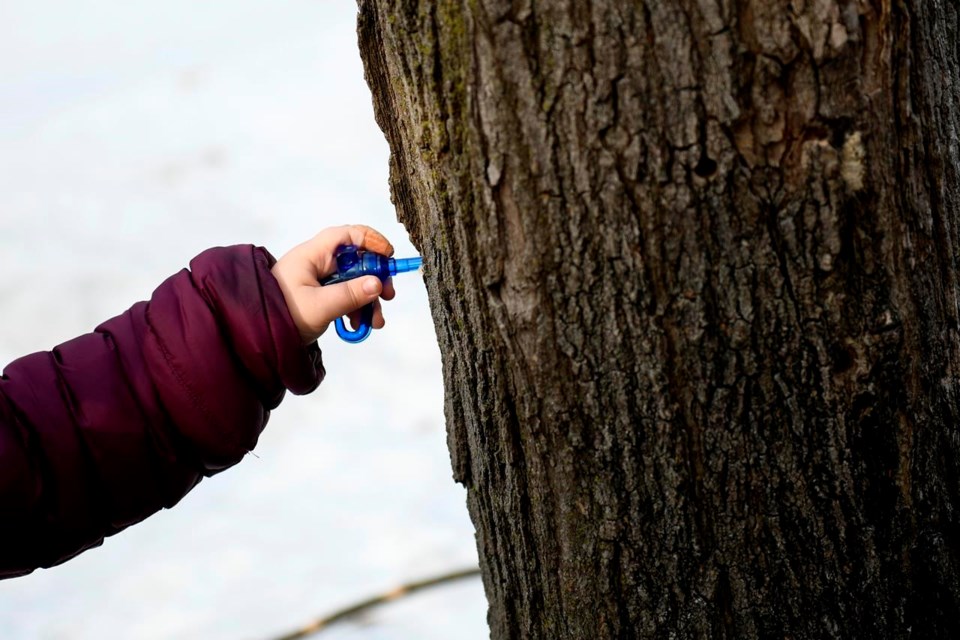Increasingly unpredictable winter temperatures have Ontario maple syrup producers concerned about how climate change will affect the industry's future, with some pushing for environmentally friendly practices to reduce the sector's carbon footprint.
Prolonged mild conditions last month had maple syrup producers in southern Ontario tapping trees for sap in early February — significantly earlier than when tapping season has historically begun in early to mid-March. A cold spell last week then forced a pause on the early start to operations.
The executive director of the Ontario Maple Syrup Producers' Association said there's evidence that spring-like weather is starting earlier each year, creating uncertainty in the delicate freeze-thaw cycles that producers rely on.
"We've always had winter thaws, but they've become more significant in the last 20 years," John Williams said in an interview.
"They've increased in the frequency we've had them and also the length of time that we stay warm, so it's harder for us to estimate when we should be tapping."
The swings in weather mean producers have to rush to tap trees when temperatures shift unexpectedly, with little time to prepare for the operations.
"We get behind the eight ball when those kinds of quick transitions happen," he said.
Changes in technology used in maple syrup production have generally helped producers deal with the issue, but the sector is watching the situation carefully, Williams said.
Some larger operations in southern Ontario have bought stands of maple trees in northern regions because the viable temperature zone for making maple syrup is shifting farther north.
Producers have also had to deal with increasingly frequent windstorms that uproot maple trees, as well as invasive pests that can spread with rising temperatures. An infestation of tent caterpillars in 2018 left some Ontario producers with 30 per cent less syrup than the year before.
The maple syrup producers association nonetheless expects substantial growth over the next 10 years, with millions of taps being added in Ontario, Quebec and some American states. And demand for maple syrup shows no sign of slowing.
Keeping up with global demand will require tapping 120 million more trees by 2080, the industry has said. That will add to the carbon levels in the atmosphere due to the wood or other fossil fuels burned to boil the sap collected from maple trees down to syrup.
Paul Renaud, who owns a sugar bush in Lanark Highlands, has been working with the maple syrup producers association to get producers to switch to carbon-neutral practices by making their sap evaporators more efficient.
It takes about 40 litres of sap to make one litre of maple syrup. Renaud said 85 to 90 per cent of emissions that a maple syrup producer has comes from the boiling of sap.
If sap evaporators are more efficient, carbon emissions can be cut down significantly, he said. Well-maintained maple trees also store more carbon via a process known as natural sequestration – in which trees take in and store carbon dioxide, helping reduce greenhouse gas emissions, Renaud said.
Efficient operations could encourage producers to tap more trees, making it unlikely for those trees to be cut down and therefore allowing more carbon to be stored in forests, he added.
The combination could eventually lead to producers having net-neutral, or even net-negative, emissions, Renaud said.
"There's no false choice between being green and being profitable," he said. "Being profitable generally means reducing waste and unnecessary expenses, and as you become more efficient, you consume less energy, your carbon footprint goes down."
Climate change is having a substantial effect on the maple syrup industry, Renaud said, and extreme weather events like windstorms can have devastating consequences. If a maple tree is blown over, it can take 40 years to grow another tree to the size required for tapping, he said.
"You can mitigate it by being part of the solution," he said. "The reality is our collective activities can make a difference."
Peter Kuitenbrouwer, a registered professional forester who is writing a book about the history of maple syrup in Canada, said an overall transition by Canadians to renewable energy is needed to help mitigate the effects of climate change and, in turn, help protect the maple syrup sector.
It's important to protect the industry from the effects of climate change because of its cultural value as well, he said.
"It's this symbol of renewal, spring, hope, kind of redemption after the misery of winter," he said. "I think that's something a lot of Canadians relate to."
This report by The Canadian Press was first published March 7, 2023.
—�Ĕ�Ĕ
This story was produced with the financial assistance of the Meta and Canadian Press News Fellowship.
Tyler Griffin, The Canadian Press



